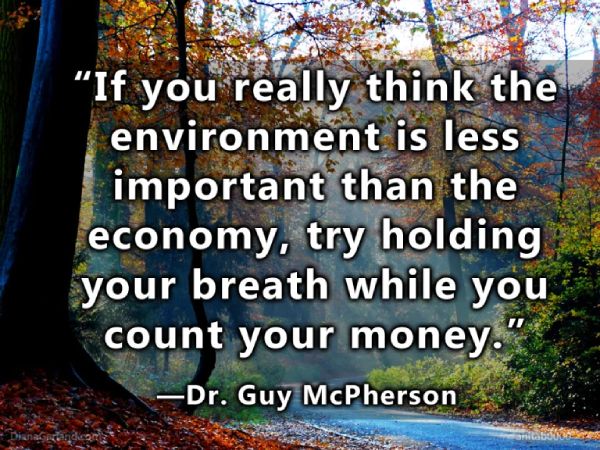American evolutionary biologist George C. Williams died in September 2010 at the age of 83 years. He is famously credited with this line: “Most evolving lineages, human or otherwise, when threatened with extinction, don’t do anything special to avoid it.”
I doubt he knew we were facing our own imminent extinction, although by the time he died, I had been sounding the alarm at guymcpherson dot com for three years. I was not alone. The warnings I will mention in this short video were hardly the first ones about climate catastrophe likely to result from burning fossil fuels. A little time with your favorite online search engine will take you to George Perkins Marsh sounding the alarm in 1847, Svente Arrhenius’s relevant, peer-reviewed journal article in 1896, Richard Nixon’s knowledge in 1969, and young versions of Al Gore, Carl Sagan, and James Hansen testifying before the United States Congress in the 1980s. There is more, of course, all ignored for a few dollars in a few pockets. After all, as Williams pointed out, “most evolving lineages, human or otherwise, when threatened with extinction, don’t do anything special to avoid it.”
We think we’re special. But, as a species, we certainly have not done anything special to avoid our own extinction. As with at least eight previous species in the genus Homo, most contemporary humans are rushing ignorantly to their own demise, concerned primarily with virtue-signaling toward other members of their own species.
The projected rate of climate change based on the type of gradualism indicated by the Intergovernmental Panel on Climate Change outstrips the adaptive response of vertebrates by a factor of 10,000 times. Closer to home Homo sapiens, mammals cannot evolve fast enough to escape the current extinction crisis. Humans are vertebrate mammals. To believe that our species can avoid extinction, even as non-human vertebrates and non-human mammals disappear, is classic human hubris wrapped in a warm blanket of myth-based human supremacy. Abundant evidence indicates humans will join the annihilation of “all life on earth,” as reported in the peer-reviewed Scientific Reports on November 13th, 2018. Why? Because we cannot keep up with the ongoing and predicted rates of environmental change. Even tardigrades, the go-to survivor for those who deny the impacts of abrupt climate change on life, are unlikely to survive, according to a paper in the January 9th, 2020 issue of Scientific Reports. If the organisms on which we depend do not survive, if even tardigrades do not survive, then humans will not survive. We depend greatly upon invertebrates for our continued existence, yet an “insect apocalypse” is under way, as reported in a review paper in the April 2019 issue of Biological Conservation and subsequently confirmed in an October 30th, 2019 paper in Nature. These are all renowned, peer-reviewed journals.
To summarize from a comprehensive review paper written by 38 scholars and published on February 25th, 2021 in the peer-reviewed Global Change Biology, “[t]he biosphere, upon which humanity depends, is being altered to an unparalleled degree across all spatial scales.ˮ The paper goes on to point out, quoting from abundant peer-reviewed evidence, that “humans have directly modified 77% of the land surface and 87% of oceans” (Watson et al.,2018)… and later, “Ecosystems are deteriorating globally, and species extinction rates are strongly correlated with both climate change and the human footprint” (Ceballos et al., 2020; Keith et al., 2013).
In other words, “only” abrupt climate change is necessary to rid Earth of all life. We could pursue other means to destroy all life on Earth. So, of course, we are.
The uncontrolled meltdown of the world’s nuclear power facilities is sufficient for the near-term loss of life on Earth. As I have pointed out previously in this space, ionizing radiation from the meltdown of nuclear power plants will strip away stratospheric ozone, leading to stunning rapid overheating of Earth. Even the writers of the 2021 film Finchunderstood this, although I receive messages nearly every day indicating we can shut down those power plants in a matter of minutes. We can’t, of course.
As I’ve pointed out frequently in this space, people believe what they want to believe. Evidence is irrelevant to the masses.
The corporate media in the United States is epitomized by the New York Times, a newspaper that admits it sends major scoops to the US government before publication, to make sure “national security officials” have “no concerns.” Although the Washington Post has yet to admit to the same, I suspect both primary mouthpieces of American Empire are equally guilty of serving the state rather than the people.
We know quite a bit more about climate science than we did in 1977. And real scientists knew, even way back then, that economists were not to be treated as scientists. It’s small wonder Nordhaus shared the politically motivated Nobel Prize in Economics in 2018. I wouldn’t have been surprised had he been given the Nobel Peace Prize, thus joining fellow partners-in-crime and specialists-in-genocide Henry Kissinger and Barack Obama.
The response to these abundant warnings, throughout history? Shift the baseline. Ignore the abundant science. Throw caution to the wind. And, for the IPCC, retain a remarkably conservative approach, from a scientific viewpoint. This, according to the remarkably conservative peer-reviewed literature.
The corporate media, governments, and most climate scientists continue to adhere to the 2 C target proposed by economist William Nordhaus in 1977: “If there were global temperatures more than 2C or 3C above the current average temperature, this would take the climate outside of the range of observations which have been made over the last several hundred thousand years.” As pointed out by professor Andrew Glikson in the Chapter 5 abstract for his October 9th, 2020 book, The Event Horizon: “During the Anthropocene greenhouse has forcing has risen by more than 2.0 W/m2, equivalent to more than >2 degrees C above pre-industrial temperatures, which constitutes an abrupt event over a period not much longer than a lifetime.”
This global-average temperature is the highest ever with any civilization present, according to a 2017 paper in Earth System Dynamics by James Hansen and colleagues. In other words, our society has never experienced a hotter Earth than the one currently driving the ongoing crisis as habitat for humans disappears. Earth has entered a “new climate regime,” as pointed out in a pre-print of the June 2019 issue of Earth’s Future: “Overall, our results suggest that we have entered a new climate regime in which the occurrence of extraordinary global-scale heatwaves cannot be explained without human-induced climate change.” By May 8th, 2020, lethal wet-bulb temperatures were contributing to human mortality on Earth.
According to an overview published by European Strategy and Policy Analysis System in April 2019: “An increase of 1.5 degrees is the maximum the planet can tolerate; should temperatures increase further … we will face even more droughts, floods, extreme heat and poverty … and at worst, the extinction of humankind altogether.” In other words, according to this major synthesis, we have passed the point that will trigger human extinction.
There are a few other means by which we could destroy all life on Earth in a short period of time. Stunningly, we seem to intent upon pursuing each of them. It’s not a contest. We’re not winning.
At the edge of extinction, only love remains.
Author
"Dr. Guy McPherson is an internationally recognized speaker, award-winning scientist, and the world’s leading authority on abrupt climate change leading to near-term human extinction. He is professor emeritus at the University of Arizona, where he taught and conducted research for twenty years. His published works include 14 books and hundreds of scholarly articles. Dr. McPherson has been featured on TV and radio and in several documentary films. He is a blogger, cultural critic, and co-host of his own radio show “Nature Bats Last.” Dr. McPherson speaks to general audiences across the globe, and to scientists, students, educators, and not-for-profit and business leaders who seek their best available options when confronting Earth’s cataclysmic changes." source
Latest Peer-Reviewed Journal Article:
McPherson, Guy R., Beril Sirmack, and Ricardo Vinuesa. March 2022. Environmental thresholds for mass-extinction events. Results in Engineering (2022), doi: https://doi.org/10.1016/j.rineng.2022.100342.









